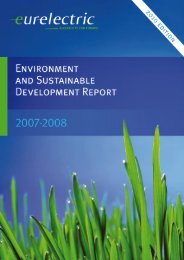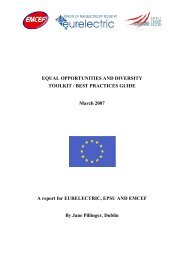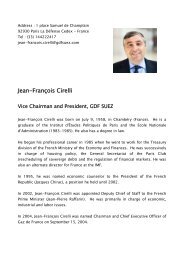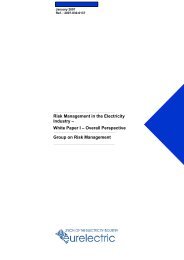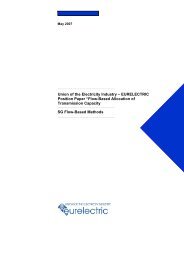Hydro in Europe: Powering Renewables - Full Report - Eurelectric
Hydro in Europe: Powering Renewables - Full Report - Eurelectric
Hydro in Europe: Powering Renewables - Full Report - Eurelectric
You also want an ePaper? Increase the reach of your titles
YUMPU automatically turns print PDFs into web optimized ePapers that Google loves.
- controll<strong>in</strong>g reactive power motion <strong>in</strong> the system (voltage regulation and<br />
reactive power control);<br />
- establishment of the rotat<strong>in</strong>g reserve by means of second power controll<strong>in</strong>g<br />
(primary control) and m<strong>in</strong>ute power controll<strong>in</strong>g (secondary control);<br />
- role <strong>in</strong> rebuild<strong>in</strong>g the national electric power system <strong>in</strong> case of a system failure.<br />
Zarnowiec was therefore an important part <strong>in</strong> manag<strong>in</strong>g the <strong>Europe</strong>an blackout of 4<br />
November 2006. Activat<strong>in</strong>g pumps helped to stabilize frequency and voltage and to<br />
reestablish the system after power failure.<br />
The role of Zarnowiec <strong>in</strong> voltage control will fundamentally <strong>in</strong>crease <strong>in</strong> the very near<br />
future, as several w<strong>in</strong>d farms are to be built <strong>in</strong> the area.<br />
CASE STUDY 5 - Norway`s important storage capacity and potential<br />
<strong>Europe</strong> has three major renewables batteries: Norway and the Scand<strong>in</strong>avian region,<br />
the alp<strong>in</strong>e region, and, to a lesser extent, the Pyrenees. Norway has a 96% share of<br />
hydropower generation <strong>in</strong> its electricity generation portfolio, produc<strong>in</strong>g on average<br />
123 TWh of electricity a year. 60-70% of the annual hydropower generation is<br />
produced from conventional storage hydropower plants.<br />
Norway has almost half of <strong>Europe</strong>’s reservoir (storage) capacity. Already today, the<br />
generation flexibility of Norway’s storage hydropower enables the <strong>in</strong>tegration of a high<br />
level of v-RES (>20%) with<strong>in</strong> the Nordic market, ma<strong>in</strong>ly from w<strong>in</strong>d <strong>in</strong> the electricity<br />
system of Denmark.<br />
Norway could provide a significant back-up to the cont<strong>in</strong>ental <strong>Europe</strong>an electricity<br />
system. Prelim<strong>in</strong>ary studies on possibilities to expand Norway’s pumped storage<br />
capacities demonstrate that there is potential of 10- 20 GW for pumped storage<br />
capacities if the exist<strong>in</strong>g reservoirs were used <strong>in</strong> a different manner. However, the<br />
follow<strong>in</strong>g challenges need to be met <strong>in</strong> order to enable the country to play this role:<br />
- <strong>in</strong>creased transmission capacity between Norway and the <strong>Europe</strong>an cont<strong>in</strong>ent;<br />
- <strong>in</strong>creased social acceptance for new transmission l<strong>in</strong>es;<br />
- <strong>in</strong>centivis<strong>in</strong>g bus<strong>in</strong>ess models for pumped storage power plants.<br />
CASE STUDY 6 - The operational evolution of pumped storage operation <strong>in</strong> Switzerland<br />
The exist<strong>in</strong>g park of fully flexible hydropower plants has been the reason why, despite<br />
good topographical and hydrological conditions, <strong>in</strong>stalled pumped storage capacity <strong>in</strong><br />
Switzerland is relatively small. Grimsel 2, the biggest pure pumped storage power plant<br />
<strong>in</strong> Switzerland, has a total <strong>in</strong>stalled capacity of 350 MW.<br />
S<strong>in</strong>ce its commission<strong>in</strong>g the operation mode of this plant has undergone some change.<br />
At the beg<strong>in</strong>n<strong>in</strong>g the plant was exclusively used <strong>in</strong> the ‘classical sense’ to balance<br />
generation. From about 2000 onwards a shift <strong>in</strong> operation mode took place, after<br />
<strong>in</strong>creased cross-border trade opened up new bus<strong>in</strong>ess opportunities. The plant<br />
enlarged their operational modes to market optimisation, while preserv<strong>in</strong>g their<br />
37



